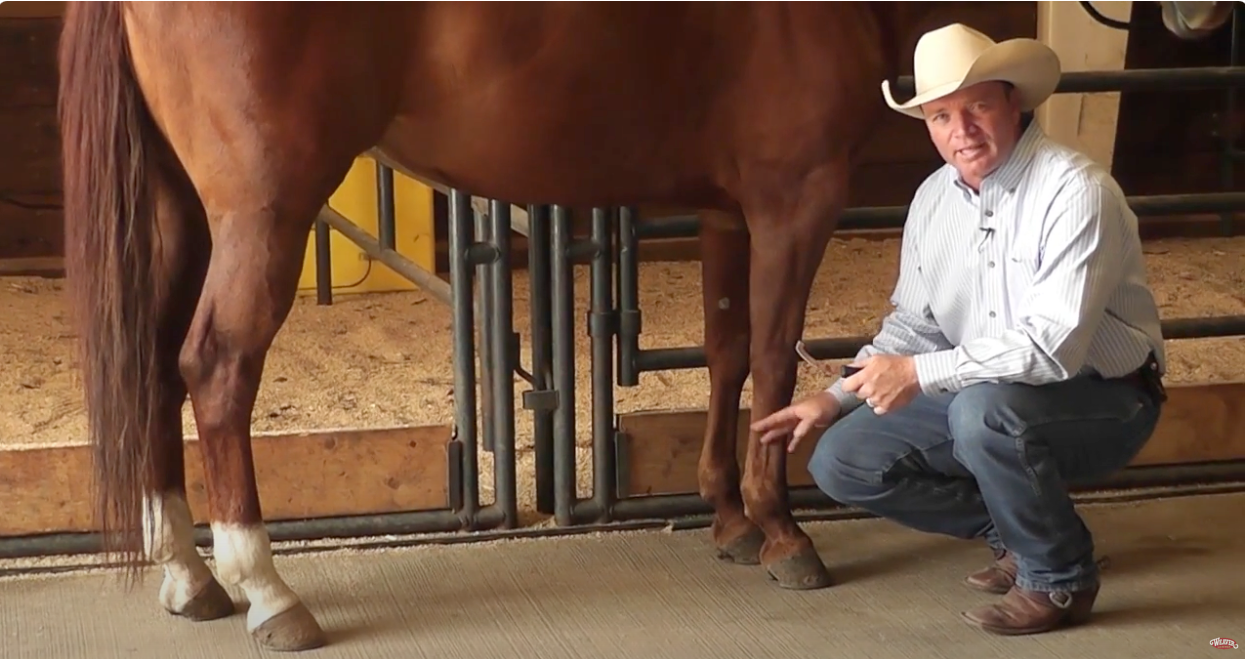You know those tiny yellow dots on your horse's legs? They look so unassuming and harmless. But one of the most persistent seasonal pests for horses and horse owners is the bot fly (Family Gasterophilidae), and those tiny yellow dots are their eggs. These parasites not only irritate horses on the outside but can also cause internal issues when their larvae develop in the digestive tract.
It's pretty gross.
To keep your horse healthy, it’s important to understand the bot fly’s life cycle, treatment options, and how to remove eggs safely.
The Bot Fly Life Cycle

According to Scott Schell, Assistant Extension Entomologist with the University of Wyoming, bot flies are highly fertile. Females can fly miles in search of a host and lay hundreds of sticky eggs on a horse’s coat. One untreated horse can generate enough adult flies to spread infestations far and wide.
The adult female flies lay eggs on horses using a long ovipositor to attach an egg to the horse's hair shaft. The fly never even lands on the horse, making topical fly sprays ineffective.
The horse consumes some of these eggs when he bites or licks his front legs. Some species lay eggs near the horse's mouth and just move in after they hatch.
Larvae live the horse’s mouth tissues for about a month before being swallowed. Once inside the digestive tract, they attach to preferred locations.
Did we mention this is gross?
There are three primary species of bot flies that affect horses in North America:
Horse Bot (Gasterophilus intestinalis)
- Prefers the front legs for egg-laying.
- Eggs hatch when stimulated by licking or biting.
- Matures in upper stomach lining
Throat Bot (G. nasalis)
- Deposits eggs under the jaw.
- Hatch within 5–6 days and crawl into the horse’s mouth without stimulation.
- Matures in duodenum (small intestine)
Nose Bot (G. hemorrhoidalis)
- Attaches dark-colored eggs to whiskers on the lips.
- Hatch when triggered by moisture during licking.
- Matures in upper stomach lining or duodenum in early stages, rectum in late stages
The larvae feed on the horse's tissues and secretions, not on what the horse eats. They can grow up to 20 millimeters long (about as wide as a nickel—we use the metric system AND anything but the metric system for reference) and remain inside the horse for several months. In spring, mature larvae exit in manure, burrow into the soil, and pupate. Adults emerge 3–9 weeks later, starting the cycle again.
Fun fact (Not really. Everything about bot flies is gross)
Adult bot flies don’t eat. They lack functional mouths and survive less than a month—long enough only to mate and lay eggs.
How Bot Flies Affect Horses
Even without internal damage, bot flies cause plenty of trouble. Their darting, egg-laying behavior often leads to:
- Stomping front legs
- Tossing heads
- Rubbing or “hiding” muzzles
- Running away from the flies
This panic is frequently mistaken for a bee sting, but horses recognize the difference. They know exactly how annoying a bot fly can be.
When to Check for Bot Flies
Bot fly eggs are most commonly seen in late summer and early fall, when adult female flies are actively laying. Warm weather and long days allow flies to thrive, and horses spending time in pastures are easy targets. Here are some things that affect bot fly behavior
-
Temperature & climate: Bot flies are most active in warm weather. Their eggs require warmth to stay viable, and adults are killed off by cold snaps. This makes late summer through early fall the height of egg-laying season, just before the first frosts end the adult population.
-
Horse exposure: Horses tend to be on pasture more during late summer and fall, giving flies easier access to hosts and more surface area for egg-laying.
-
Life cycle timing: The cycle is designed to overwinter in the horse. By laying eggs in late summer/early fall, larvae can hatch, migrate into the mouth and digestive tract, and then spend the winter attached to stomach or intestinal tissues. This ensures their survival until they are passed in manure and pupate the following spring.
-
Behavioral drive of adults: Female bot flies are short-lived (less than a month) and don’t feed, so their single purpose is reproduction. As summer progresses, more adults emerge from soil pupae, and populations surge — making August through October their most aggressive egg-laying window.
Treating and Preventing Bot Flies
Schell emphasizes that effective bot fly control combines seasonal deworming with egg removal:
- Use a deworming product effective against bot fly larvae after the first hard frost, when adults die off but larvae remain inside the horse. This timing interrupts the life cycle before larvae pupate in soil.
- In the late summer and fall, scrape away the tiny yellow eggs on the legs and body with a bot fly knife or abrasive grooming block.
- Avoid razors, which can injure the horse.
- Always wash your hands after egg removal.
- Avoid contact with eyes or mouth; accidental exposure can cause temporary myiasis (maggot infestation) in humans.
- Adult bot flies hover rather than land, so most fly sprays and repellents are ineffective.
Using a Bot Fly Knife
The Weaver Equine Bot Fly Knife is specifically designed for safe, effective removal of sticky bot fly eggs. Ken McNabb, professional horseman, shares how he uses a bot fly knife:
- Step 1: Restrain your horse safely.
- Step 2: Hold the knife at a shallow angle and gently scrape down the hair shaft.
- Step 3: Collect and discard the eggs away from feed or water.
- Step 4: Wash the area and your hands after removal.
Unlike makeshift methods, the bot fly knife makes the process faster, safer, and more comfortable for your horse.
Shop the Weaver Equine Horse Bot Fly Knife here
In Summary
- Bot flies lay hundreds of eggs each summer, with larvae migrating into the horse’s GI tract.
- Bot fly activity peaks in late summer and fall, when warm weather and rising populations drive females to lay hundreds of eggs on horses.
- Control is best achieved with summer egg removal and fall deworming.
- The Weaver Equine Bot Fly Knife is a practical grooming tool to manage infestations.
- Proactive grooming and parasite management can break the bot fly cycle and keep your horse comfortable all season long.
Frequently Asked Questions About Horse Bot Flies
1. What are bot flies in horses?
Bot flies are parasitic insects in the family Gasterophilidae. Adult females lay sticky eggs on a horse’s coat. When ingested, the eggs hatch into larvae that develop in the horse’s mouth and digestive tract before being passed in manure to complete their life cycle.
2. Do bot flies harm horses?
Yes. While many infestations are mild, larvae can cause irritation in the mouth, stomach, and intestines. Heavy infestations may lead to poor condition, colic, or digestive issues. Even if internal damage is minimal, the adult flies harass horses, causing stress and dangerous panic behaviors.
3. When should I deworm my horse for bot flies?
Veterinary experts, including University of Wyoming Extension entomologist Scott Schell, recommend deworming in the late fall after the first hard frost. At this time, adult flies are gone, but larvae are still present inside the horse’s GI tract. This timing prevents further development and helps break the cycle.
4. How do you remove bot fly eggs from a horse?
The safest way is to use a bot fly knife or an abrasive grooming block. Scrape gently along the hair shaft to dislodge the sticky yellow or dark eggs. Avoid razors, which may cut the horse’s skin. Always wash your hands afterward to prevent accidental contact with your eyes or mouth.
5. Where do bot flies lay their eggs?
Different species prefer different locations:
- Horse bot (G. intestinalis): front legs and shoulders
- Throat bot (G. nasalis): under the jaw
- Nose bot (G. hemorrhoidalis): whiskers and lips
Regardless of egg location, all larvae eventually migrate to the mouth and then horse’s digestive system.
6. Do fly sprays protect horses from bot flies?
Not effectively. Bot flies hover and rarely land, so most repellents don’t work. Instead, focus on regular egg removal and timed deworming to reduce infestations.
7. When are bot fly eggs most common on horses?
Bot fly eggs are most common in late summer and early fall, when conditions favor peak activity for the adult flies. Warm temperatures keep eggs viable, and horses on pasture are easy targets. This timing also allows the larvae to hatch, migrate into the horse’s mouth, and settle into the digestive tract to overwinter, ensuring their survival until spring. Adult females, which live less than a month and exist only to reproduce, emerge in larger numbers during this season. They hover and dart around horses, using a long ovipositor to glue eggs onto the coat. Their persistence often startles horses, leading to stomping, head tossing, or bolting to avoid the flies.
8. Can humans get bot flies from horses?
Yes, but rarely. If a person accidentally gets bot eggs into their mouth or eye while handling horses, the larvae can cause a temporary condition called myiasis (maggot infestation—did we mention bot flies are gross?). Practicing good hygiene, like washing hands after removing eggs, greatly reduces this risk.

